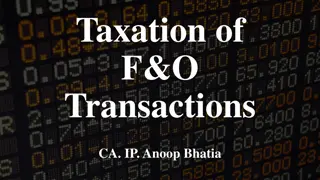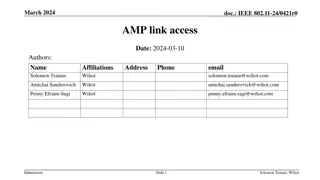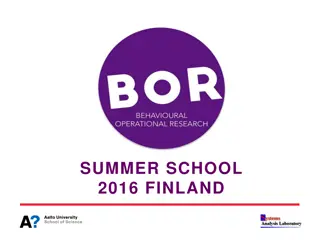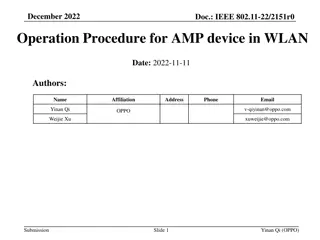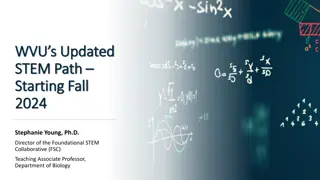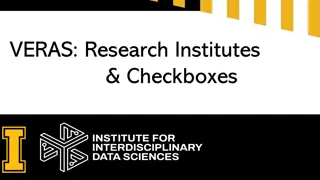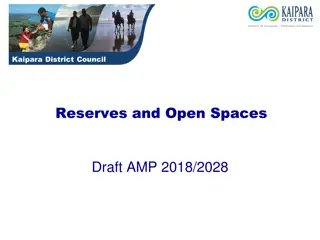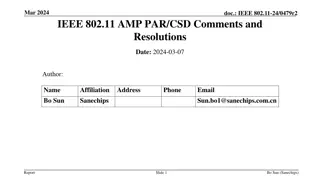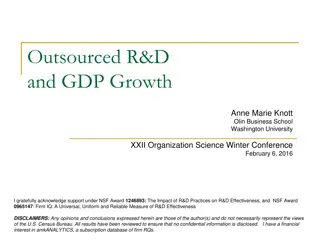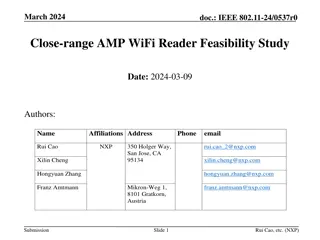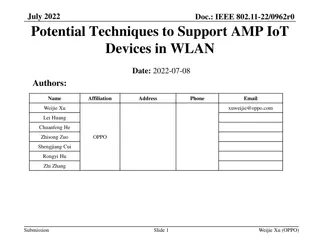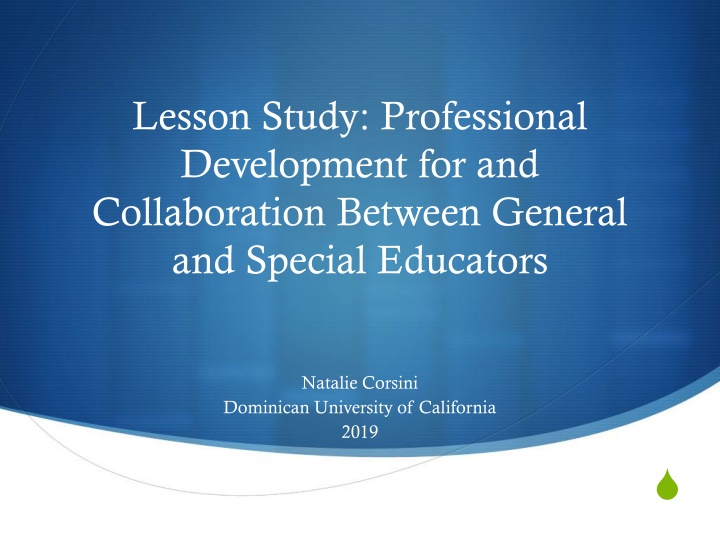
Collaboration and Professional Development in Special Education
Explore the challenges faced by special education teachers, the need for improved working conditions, and the benefits of collaborative professional development initiatives. Learn about the theoretical frameworks, common methods of collaboration, and the gap in research within special education. Discover strategies to enhance teacher support, reduce isolation, and enhance student outcomes.
Download Presentation

Please find below an Image/Link to download the presentation.
The content on the website is provided AS IS for your information and personal use only. It may not be sold, licensed, or shared on other websites without obtaining consent from the author. If you encounter any issues during the download, it is possible that the publisher has removed the file from their server.
You are allowed to download the files provided on this website for personal or commercial use, subject to the condition that they are used lawfully. All files are the property of their respective owners.
The content on the website is provided AS IS for your information and personal use only. It may not be sold, licensed, or shared on other websites without obtaining consent from the author.
E N D
Presentation Transcript
Lesson Study: Professional Development for and Collaboration Between General and Special Educators Natalie Corsini Dominican University of California 2019
How do we improve the working conditions for teachers? Statistics show that 50% of teachers leave the profession within the first five years (Dicke, Stebner, Linninger, Kunter, & Leutner, 2018). Samuels and Harwin (2018) report that the special education teacher population has decreased by 17% in the last decade, while the special education student population has only decreased by 1%.
The Problem Special education teachers report feelings of isolation, lack of collaboration, a lack of understanding about what they do, and an overall lack of support (Gersten, Keating, Yovanoff & Harniss, 2001). Attrition rates are higher in special education, more than any other teacher group, with special educators leaving at a rate of 13% each year (Emery & Vandenberg, 2010).
Theoretical Framework Collaboration Professional Development Mostly top-down Increases feelings of support Decreases isolation and improves self-efficacy Improves student behavior and academic achievement Improves student outcomes Improves teacher skills and performance Improves teacher skills, strategies, and best instructional practices (Apsari et al., 2017; Ciarocco et al., 2016; Ibrahim & S leyman Yildiz, 2017; Van Schalkwyk, Leibowitz, Herman, & Farmer, 2015). (Ibrahim & S leyman Yildiz, 2017; Egodawatte et al., 2011; Van Schalkwyk, Leibowitz, Herman, & Farmer, 2015; Shachar & Shmuelevitz, 1997).
Theoretical Framework Hierarchy in Special Education General education teacher is perceived as being responsible for curriculum and content knowledge in order to teach a whole class (Langovic-Milicvic et al., 2013). Commonly Researched Methods of Collaboration and Professional Development Professional Learning Community Co-teaching Special educator is perceived as the teacher with the specialized knowledge, such as adapting materials and implementing assessments (Langovic-Milicvic et al., 2013). Lesson Study (Bjuland & Mosvold, 2015; Groves, Doig, Vale, & Widjaja, 2016; Khairuddin et al., 2016; Legutko, 2015; Wells & Feun, 2013) Deficit Model in Special Education: Students with deficits need fixing
Gap in Research Need more sustainable teacher-led professional development geared towards teachers daily and ongoing needs Need more opportunities for special educators to improve teaching practices (rather than sole focus on IEPs) Need more collaborative opportunities to break down separation between general education and special education roles
RESEARCH QUESTION How does Lesson Study as a form of professional development affect collaboration between general education and special education teachers? How does collaboration between general and special education teachers affect the working conditions of special educators? How do we address the perceived separate roles between general and special educators in United States education?
Methodology Participants: 2 special education teachers and 2 general education teachers Student Participants: at grade level students, below grade level students, English Language Learners, special education students School-site: Elementary School in San Francisco Bay Area Lesson Study Format (4 Lessons total) 1) Pre-discussion 2) Teaching the lesson 3) Post-discussion
Data Collection Explanatory Sequential Mixed Methods Research Multi-case research Quantitative Teacher survey results after each Lesson Study Qualitative Pre/post discussions: videotaped and transcribed Post Lesson Study interviews: audiotaped and transcribed
Findings Theme: Experiencing Collaboration Requested support and constructive feedback Theme: Cyclical Problem- Solving Lead teacher posed a problem to the team, but problem never solved Reflected Received Support (compliments and encouragement) Asking and answering questions, giving and receiving feedback and support, and sharing shortcomings continued indefinitely Improved all teachers (regardless of role) The collaboration between participants and colleagues was mutually beneficial
Findings Theme: Breaking Down the Hierarchy Theme: Breaking Down Barriers to between General and Special Education Collaboration and Professional Development Special educators shared information with general educators and general educators shared information with special educators Teacher-led and teacher choice Improved instructional practices Separation between roles was blurred Time mutually negotiated Challenged the Deficit Model in special education Student strengths Teachers adapted own instruction and materials All done within contract hours
? Teacher Survey Results ?
Teacher Survey Results ?
Improving Professional Development and Instructional Practices . but it made me push myself even more. How am I going to teach summarizing? I can t just throw it at them, what can I do? It made me really dig deeper and made me think, I gotta do this with all of my lessons. It was really good because you just learn new ideas too and support and again that s just so missing in our professional development. I don t know why that s not [happening] every week. You re with a group the whole year and you bounce ideas and it's a support system too; you are assigned to it.
Opportunities to Reflect and Open Dialogue I would say just having the conversation, the back and forth dialogue was good. I would say it's good to be like the team we had. It s good to have people you feel like you can be open and honest with. And not feel like judged or anything like that. I loved that we shared our plan and then reviewed it afterwards. I loved that every time we did it, we recognized that there were great things that happened, and we recognized that there were things we needed to improve on.
Implications Lesson Study as meaningful collaboration between general and special educators Special educators included in professional development opportunities focused on improving teaching practices Special education and general education roles blurred All teachers and all students treated equally and with respect in their ability to learn Lesson Study as teacher-led form of collaborative professional development, available to all teachers
What do we do now? Make Lesson Study available and sustainable for general and special education teachers to use as a teacher-led form of collaborative professional development Provide more opportunities for special educators to develop as teachers (e.g. instructional practices) Provide more opportunities for special and general educators to collaborate in a meaningful way Provide more methods/tools to break down the separation between general and special education programs (e.g. co- teaching, Lesson Study)
References Apsari, Y., Isry, L. S., & Rissa, S. R. (2017). Promoting English teachers professional development (tpd) through the practice of lesson study. Okara: Journal Bahasa Dan Sastra, 11(2), 303-318, doi:10.19105/ojbs.v11i2.1496 Bjuland, R., & Mosvold, R. (2015). Lesson study in teacher education: Learning from a challenging case. Teaching and Teacher Education, 52, 83-90. doi:10.1016/j.tate.2015.09.005 Ciarocco, N. J., Dinella, L. M., Hatchard, C. J., & Valosin, J. (2016). Integrating professional development across the curriculum. Teaching of Psychology, 43(2), 91-98. doi:10.1177/0098628316636217 Dicke, T., Stebner, F., Linninger, C., Kunter, M., & Leutner, D. (2018). A longitudinal study of teachers occupational well-being: Applying the job demands-resources model. Journal of Occupational Health Psychology, 23(2), 262-277. doi:10.1037/ocp0000070; 10.1037/ocp0000070.supp Egodawatte, G., McDougall, D., & Stoilescu, D. (2011). The effects of teacher collaboration in grade 9 applied mathematics. Educational Research for Policy and Practice, 10(3), 189-209. Retrieved from https://link.springer.com/journal/volumesAndIssues/10671 Emery, D. W., & Vandenberg, B. (2010). Special education teacher burnout and ACT. International Journal of Special Education, 25(3), 119 131. Retrieved from http://www.internationalsped.com/policy.cfm Gersten, R., Keating, T., Yovanoff, P., & Harniss, M. K. (2001). Working in special education: factors that enhance special educators intent to stay. Exceptional Children, 67(4), 549. doi:10.1177/001440290106700408
References Groves, S., Doig, B., Vale, C., & Widjaja, W. (2016a). Critical factors in the adaptation and implementation of Japanese lesson study in the Australian context. ZDM Mathematics Education, 48(4), 501. doi:10.1007/s11858-016-0786-8 Ibrahim, H. A., & S leyman Yildiz. (2017). Professional development of elementary school teachers through online peer collaboration: A case study. Turkish Online Journal of Qualitative Inquiry , 7(4), 422-439. doi:10.17569/tojqi.79480 Khairuddin, K. F., Dally, K., & Foggett, J. (2016). Collaboration between general and special education teachers in Malaysia. Journal of Research in Special Educational Needs, 16(S1), 909-913. doi:10.1111/1471-3802.12230 Legutko, R. S. (2015). One secondary school s subject-area teachers perspectives on co-teaching students with special needs. Online Submission. Retrieved from https://eric.ed.gov/?id=ED558191 Samuels, C. A., and Harwin, A., (December 5 2018). Special education Practice and pitfalls: Shortage of special educators adds to classroom pressures. Education Week. Retrieved from https://www.edweek.org/ew/articles/2018/12/05/shortage-of-special-educators-adds-to-classroom.html. Shachar, H., & Shmuelevitz, H. (1997). Implementing cooperative learning, teacher collaboration and teachers' sense of efficacy in heterogeneous junior high schools. Contemporary Educational Psychology, 22(1), 53-72. doi:10.1006/ceps.1997.0924 Van Schalkwyk, S., Leibowitz, B., Herman, N., & Farmer, J. (2015). Reflections on professional learning: Choices, context and culture. Studies in Educational Evaluation, 46, 4-10. doi:10.1016/j.stueduc.2015.03.002
Thank you! Questions? Are you interested in learning more? Reach out to Natalie Corsini nmcorsini@gmail.com For access to full thesis visit: https://scholar.dominican.edu/

